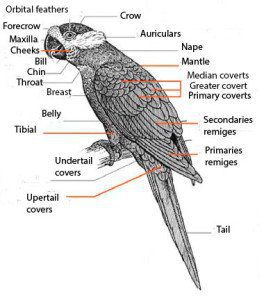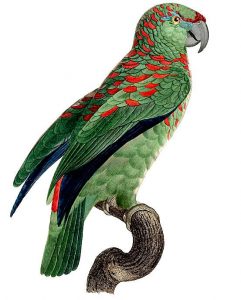Content |
|---|
Description
38-41 cm.. tall and 370g. weight.
The Festive Parrot (Amazona festiva) has the cheeks and sides neck Green with strong blue diffusion; lores and a close frontal band red; feathers above and behind them eyes blue; Forehead rather yellowish green. Crown Green but darker; Feathers of the nape of color green with a band terminal dark. Mantle, scapulars, top of the back and uppertail-coverts dark green; Rump and the greater part of the low back bright red. Primary coverts Violet Blue. Other coverts dark green.
Edge carpal of the wing and margin of the outerweb of the primaries, blue; innerwebs black; secondaries dark blue-tipped, secondaries more interior Green. Underwing-coverts green. Chin and throat blue; Breast and belly green; coverts infra-flows brighter yellowish green. Tail green, of paler green yellowish at the tip; Trace reddish at the base of some feathers.
The bill color cuerno-marron; Iris yellow, legs dark grey.
Both sexes are similar.
Immature have irises dark and show a less intense color in the head. Its back low is practically Green; some of the pens outside of it tail they have a red base.
- Sound of the Festive Parrot.
Subspecies description
-
Amazona festiva bodini
(Finsch, 1873) – It has a broadband Violet Blue and red in the front behind the eyes.
-
Amazona festiva festiva
(Linnaeus,1758) – The nominal.
Habitat:
Video – "Festive Parrot" (Amazona festiva) |
|---|
The Festive Parrot they attend primary and secondary lowland forests, mainly várzea, swamp forest and River Islands, as well igapó (permanently flooded forest), usually are found near the water and can prevent forests of Earth firm, although also reported in gallery forests and savannahs with scattered trees.
Observed in cocoa plantations in Brazil. At altitudes of 500 metres in Colombia and 100 metres in Venezuela. Usually in small flocks with larger meetings occasionally reported. Flocks of up to 50 birds are about Leticia between the months of May-June. Tend to gather is by the afternoon and in the evening in products communal.
Reproduction:
It nests in hollow of trees dead between mayo to June.
A breeding pair averages 3 eggs in each clutch and the incubation period is generally about 28 days.
Food:
Usually in numerous flocks, little of its power is known.
Distribution:
The Festive Parrot found in the North of South America mainly as two large populations disjunct in the basins of the amazon and Orinoco.
A population occupies the Northwest of Guyana (very few records) and Venezuela in southern Apure in the Meta River and a half Orinoco to Delta Amacuro.
The second extends from parts of the lowlands of the East (Colombia including the lower part of the Casanare River, lower Meta River and Vaupes River towards the South through the amazon of Ecuador (where birds are reported in Napo River, but few recent records) and northeast of Peru, and further to the East through the West of Brazil, from Rio Branco, Black river and bottom of the Madeira river up to the Basin Amazon East in Amapá and For and at the mouth of the amazon on Ilha Mexiana (where is its status uncertain).
Probably in its greater part resident, Although sporadic Bird on the edge of its distribution area in Ecuador and Guyana, They suggest seasonal movements outside their range, obviously low in Guyana and local in Venezuela, Ecuador and Peru, but more common in parts of the Amazonia occidental in Brazil and locally the Amazona more common in some areas Colombia (for example by of Leticia).
Pursued to the trade in live birds in parts of its area of distribution (for example, Peru). Its swampy habitat is not much in demand for agriculture, by what does not seems to have a contraction apparent large scale of its population.
Subspecies distribution:
-
Amazona festiva bodini
(Finsch, 1873) – It is from Colombia to the basin of the Orinoco of Venezuela
-
Amazona festiva festiva
(Linnaeus, 1758) – The nominal.
Conservation:
State of conservation ⓘ |
||
|---|---|---|
 Near Threatened ⓘ (UICN)ⓘ
Near Threatened ⓘ (UICN)ⓘ
| ||
• Current category of the Red List of the UICN: Least concern.
• Population trend: Decreasing.
While it has declined locally, still fairly common throughout much of its range, and may even be close to cities as Manaus and Iquitos.
The size of the world population It has not been quantified, but this species is described as “Rare”
Consequently, is considered of least concern by BirdLife International and the IUCN , Although it was categorized as vulnerable in 2012, because of patterns of deforestation in the Amazon rainforest and the susceptibility to hunt, predicts that the population will decrease quickly during the next three generations.
Festive Parrot in captivity:
Very rare in captivity.
His temperament is extremely excitable. Males tend to be aggressive. Good to excellent imitator.
It feeds on the sunflower seeds or other provided you ,fruit, vegetables etc..
Alternative names:
– Festive Parrot, Festive Amazon, Red-backed Amazon, Red-backed Parrot (English).
– Amazone tavoua, Amazona festiva (French).
– Blaubartamazone (German).
– Papagaio-da-várzea, papa-cacau, tauá, tavua (Portuguese).
– Amazona de Lomo Rojo, Amazona Festiva, Lora Festiva (español).
– Lora Festiva (Colombia).
– Loro de Lomo Rojo (Peru).
– Loro Lomirrojo (Venezuela).
scientific classification:

– Order: Psittaciformes
– Family: Psittacidae
– Genus: Amazona
– Scientific name: Amazona festiva
– Citation: (Linnaeus, 1758)
– Protonimo: Psittacus festivus
Festive Parrot Images:
Sources:
- Parrot Book, Parrots and macaws Neotropical
- avibase
Photos:
(1) – Festive Amazon at Loro Parque, Teneriffe By derivative work: Snowmanradio (talk)Festive_Amazon_BW. JPG: Berthold Werner (Festive_Amazon_BW. JPG) [Public domain], via Wikimedia Commons
(2) – A Festive Amazon at Tulsa Zoo, USA. This subspecies is known as Bodinus’ Amazon By Christopher G from Tulsa Oklahoma, USA (Amazon Parrot) [CC BY-SA 2.0], via Wikimedia Commons
(3) – A pet Festive Amazon By Tutu … F. Lopes (originally posted to Flickr as ♠) [CC BY 2.0], via Wikimedia Commons
(4) – Two Festive Amazons in an aviary at a bird park in Kaluga Oblast, Russia. They are the subspecies Amazona festiva bodini, common name Bodinus’ Amazon. They are probably jostling for room on their perch By Remiz [CC BY-SA 2.0], via Wikimedia Commons
(5) – Festive Parrot By derivative work: Snowmanradio (talk)Amazona_festiva-8.jpg: frank wouters [CC BY 2.0], via Wikimedia Commons
Sounds: Sergio Chaparro Herrera







